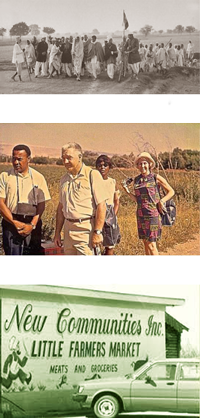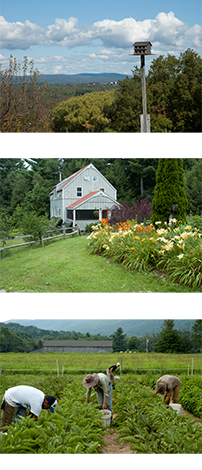A Brief History of Community Land Trust in the Southern Berkshires and Berkshire Community Land Trust
 The roots of the community land trust movement are deep and wide. From the Jewish National Fund begun in Israel in 1901, to the Gramdan Village Movement in India started in the 1950s, to New Communities, Inc., the first community land trust in the United States founded in Albany, Georgia in 1969. These pioneering organizations sought to organize everyday people to solve the issue of access to land for homes, farms and businesses.
The roots of the community land trust movement are deep and wide. From the Jewish National Fund begun in Israel in 1901, to the Gramdan Village Movement in India started in the 1950s, to New Communities, Inc., the first community land trust in the United States founded in Albany, Georgia in 1969. These pioneering organizations sought to organize everyday people to solve the issue of access to land for homes, farms and businesses.
Bob Swann and Slater King, together with other Black leaders in Georgia, organized New Communities, Inc. after a visit to Israel to witness the work of the Jewish National Fund. They were concerned that African Americans were excluded from land ownership in the South.
King was a leader of the “Albany Movement” in Georgia. Swann was a carpenter asked to lead Black and White crews in the rebuilding of bombed Black churches in the South. Together they explored an appropriate structure for new methods of land tenure that placed land in a commons, but then leased it with equity in the buildings to people committed to living and working on the land. New Communities began with the purchase of 5,600 acres of rural land, at that time the largest tract of land in the United States owned by African Americans.
Bob Swann spent two and a half years in prison during World War II as a conscientious objector. He was deeply concerned about how people live on the planet, consume its resources and build wealth. During that time he concluded there were three root causes of war: the commodification of land, the monopoly held by nations in creating and distributing money, and the loss of community in the face of ever more powerful global economic interests. In 1980, with his partner, Susan Witt, he founded the E. F. Schumacher Society (today called Schumacher Center for a New Economics). In the same year, together with interested partners in the Southern Berkshires, they founded the Community Land Trust in the Southern Berkshires (CLTSB). In 2015 CLTSB helped form a sister organization, the Berkshire Community Land Trust, to expand its capacities to hold multiple kinds of land.
Dr. Ernst Friedrich Schumacher lived from 1911 to 1977, and is best known for his book, Small Is Beautiful: A Study of Economics As If People Mattered, published in 1973. He was an inspiration for Bob Swann. Their work forms the guiding principles for the Schumacher Center and the development of community land trusts, alternative currencies, microcredit, and community-supported industry. These human-scale tools are effective because they are driven by citizen action through democratically structured organizations serving place-based communities. They are designed to balance people, planet and profits in perpetuity.
ALVASTRA
In 1980 Bob Swann and Susan Witt were invited out to the Berkshires from their Cambridge, MA offices to help form a community land trust. With interested members of the Berkshire region they incorporated the Community Land Trust in the Southern Berkshires. The first acquisition of land was a ten acre site purchased for $25,000 at then market rate in Egremont, Massachusetts. The previous owners had named the site “Alvastra” which is Gaelic for “close to the stars.” On the land sat two houses, a garage, a workshop and an orchard. Eventually the garage became a house and the workshop became a home for the Schumacher Center’s Library. In 2003, The Nature Conservancy donated an additional acre to the settlement. Today, three homes, a residence for those with disabilities, the library and the orchard occupy eleven acres.
The founding documents created in 1980 have withstood the test of time, legal challenges and community evolution. The bylaws established an open, democratic organization of community members with a shared vision for the future. A tripartite board of trustees was structured to include community members, leaseholders and local professionals with relevant expertise. The lease agreements were devised to enable occupants to build wealth with equity in their improvements on community-owned land. The land use plan made the connection between living on the land and quality of life.
 FOREST ROW
FOREST ROW
In 1986, Swann and Witt led the development of Forest Row on 21 acres of community-owned land in the town of Great Barrington, Massachusetts, just a few miles from Alvastra. Forest Row is a neighborhood of 18 households near the village center. The homes are clustered on five acres in two quadruplexes, three duplexes, and four single-family buildings. The rest of the site is predominantly wooded and wetlands. The land use plan allows for the addition of a community center, which has not been constructed.
The vacant land was purchased for $65,000. The CLTSB received a Planned Unit Residential Development (PURD) permit from the Town of Great Barrington. Forest Row homeowners lease the land for a 98-year term. The Forest Row Land Use Plan broadly determines how the land may be used within ecological guidelines. The Forest Row Association is organized by the residents and manages the neighborhood. The Forest Row lease requires that Forest Row is the primary place of residence of the leaseholder, defined as occupancy for a minimum of eight months per year.
The original financing to build Forest Row came in loans from committed members of the CLTSB and from a local bank. No government subsidy programs were used to develop the neighborhood. In addition, in order to help first time home buyers purchase homes at Forest Row, a group of Berkshire second homeowners created a pool of low-interest second mortgage funds to help with down payments. This pool, managed by the CLTSB, was known as The Fund for Affordable Housing. The Fund employed the skills of its members to build one of the single-family homes at Forest Row and offer it to a local family at below replacement costs.
INDIAN LINE FARM
In 1998, Community Land Trust in the Southern Berkshires purchased 17 acres of land for $45,000 at Indian Line Farm. Three organizations collaborated to produce the lease agreement, land use plan, and land management plan: the Community Land Trust in the Southern Berkshires, the Schumacher Center for a New Economics and the Berkshire Highlands Program of The Nature Conservancy. The goal was to maintain a working organic farm, protect the adjacent sensitive wetlands, and provide small-scale farmers with affordable access to land.
The Nature Conservancy acquired conservation easements on the property to permanently limit future development, while CLTSB acquired the title to the land and is leasing it to the farmers on a 98-year basis. The farmers purchased the house, barn, and other buildings, and will gain equity through any improvements made to the farm during their tenure (including improvements to soil quality). The lease requires good agricultural practices based on 1997 organic standards, limits the number of pounds of livestock on the land, and requires the food produced to be for people living in local/regional markets. The CLTSB retains an option to purchase the buildings and improvements, and to resell them to another farmer.
Schumacher Center provided guidance for this model, which makes critical connections between ecology, economy, and community — protecting habitat, preserving agriculture and keeping small-scale farming viable. The participation of the two land trusts provided a way for Berkshire residents to finance the purchase of the land. Indian Line Farm is the first “community-supported agriculture (CSA)” farm in the United States, originally founded by Robyn Van En, who coined the term in her quest to build a stable local market for her farm products.
TWO TIER MODEL CLT
The Community Land Trust in the Southern Berkshires, together with its sister organization the Berkshire Community Land Trust (BCLT) are pioneering a two-tier model for community land trusts to enable them to scale up efficiently and operate more effectively. The two-tier model brings together in tier one a 501(c)(3) charity (BCLT) and in tier two a 501(c)(2) asset holding company (CLTSB). Academic and religious institutions commonly use the two-tier model to separate their charitable work from the operations of managing their income-generating real estate assets.
Our strategy is to operate BCLT as a regional education non-profit building public awareness of community land trusts and generating demand for their solutions. The organization will be a regional center of expertise offering other emerging community land trusts education programs, technical support and administrative services, as well as fundraising capacity. Utilizing these services, CLTSB and other Berkshire based community land trusts organized as 501(c)(2)s will hold title to and manage land, and oversee leases, rent collection, purchase and sale, and buyer selection. As required by the IRS, BCLT and CLTSB will have linked bylaws and share some board members. CLTSB will turn over all income after expenses to BCLT at the end of each year.
This two tier structure enables the two organizations to take on activities we consider essential to the stewardship of local economies but that are not supported by a single purpose tax-exempt organization:
1.) Developing and implementing buyer (occupant) selection criteria to meet community goals, such as residency-based criteria for local owner occupancy, or skills-based criteria for farmers and workforce, or role-based criteria for organizations and businesses
2.) Selecting occupants from low-, moderate- and middle-income groups to achieve economic integration
3.) Implementing re-sale formulas that enable owners of buildings and other improvements on the land to have full equity equal to the replacement value of improvements adjusted for deterioration.
We believe this two-tier model for community ownership of land for homes, farms and businesses will permanently protect strategic land assets, cultivate social diversity, and build economic resilience. We hope to advance a broad social movement supporting community ownership of land by developing a culture of philanthropy — a land gift movement — to return land to the community commons.







